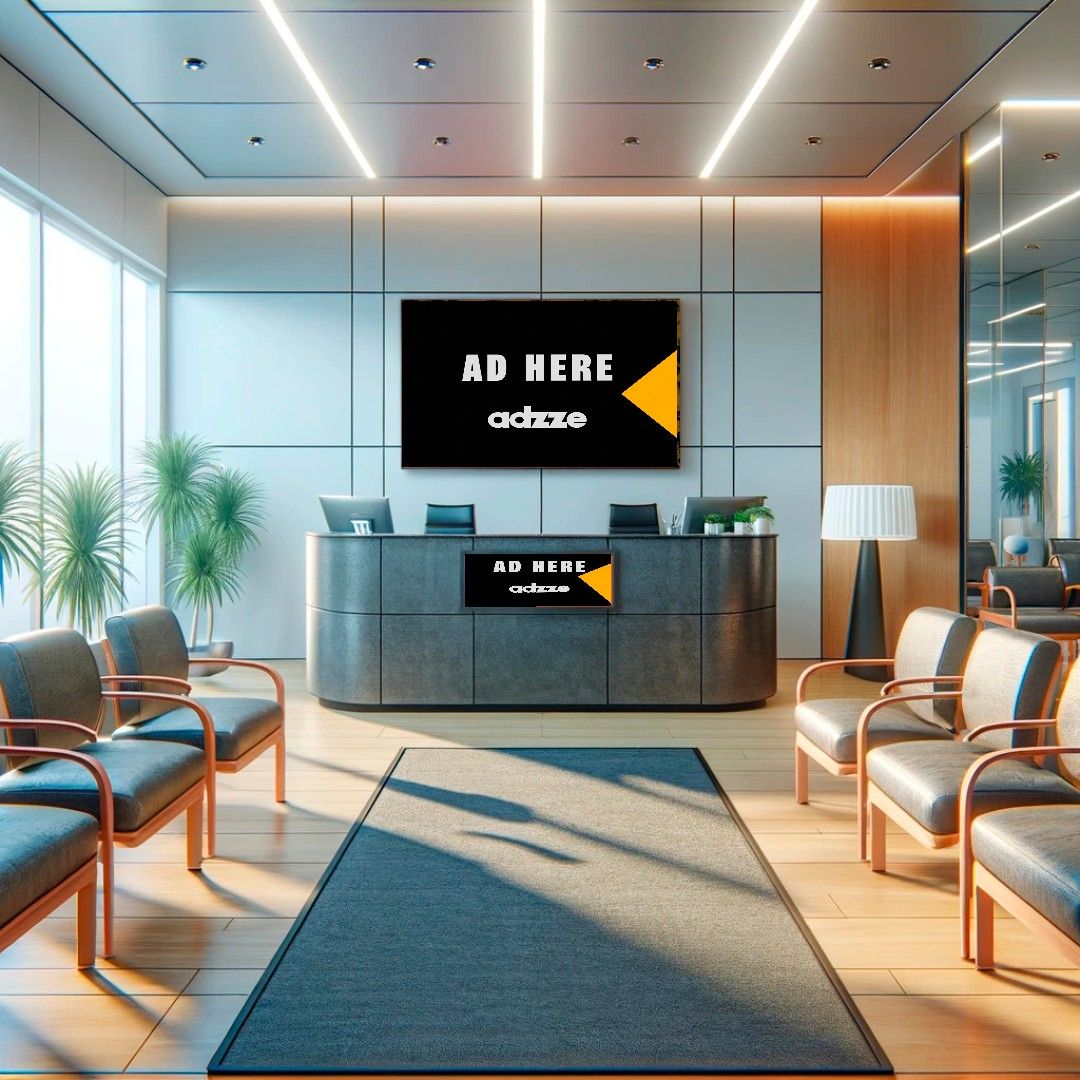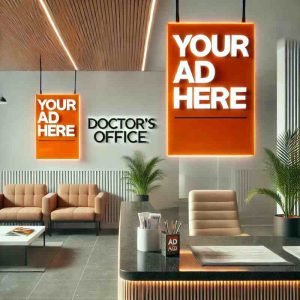Have you ever found yourself flipping through outdated magazines while waiting for a doctor’s appointment? Imagine replacing that idle time with dynamic content that informs, entertains, and even encourages patients to take action. That’s the power of digital advertising in doctor’s office waiting room settings. By leveraging screens, monitors, and interactive kiosks in these high-dwell-time environments, healthcare advertisers can engage a unique audience that’s both captive and often open to relevant messaging.
In this blog, we’ll dive deep into how this innovative approach works, why it’s particularly effective for healthcare-focused brands, and how you can tap into this underutilized marketing space to drive meaningful results.
How It Works: Doctor’s Office as Prime Advertising Real Estate
The concept behind digital advertising in doctor’s office waiting rooms is simple yet effective. Rather than relying on static posters or old magazines to fill patient downtime, medical offices install digital screens—like TVs, interactive monitors, or tablets—that display carefully curated content. This content can range from health tips to targeted product ads, offering a more engaging and modern experience than traditional methods.
1. Strategic Placement 
High-Traffic Areas: Waiting rooms, reception counters, and main hallways are prime locations where patients are guaranteed to spend at least a few minutes.
Exam Rooms: Some offices also place smaller screens in exam rooms to engage patients between consultation moments, ensuring multiple touchpoints.
2. Content Scheduling
Rotating Ads: Digital ads run on a loop, typically interspersed with educational or entertaining segments. This rotation can be customized by day, time, or even specific healthcare services being promoted.
Live Feeds: Some advanced systems integrate live updates—like weather or health news—to keep the stream fresh and maintain viewer interest.
3. Interactivity
Touchscreen Kiosks: In some cases, interactive displays allow patients to navigate health information, learn about products, or complete patient intake forms. Advertisers can embed banners or short video clips that appear upon usage.
4. Compliance and Privacy
HIPAA-Friendly Approach: Ads must remain general and avoid revealing patient info or personal content. Keeping messaging aligned with healthcare compliance ensures a seamless fit in the doctor’s office environment.
Benefits: Why Digital Advertising in Doctor’s Offices Works
Ready to see why this strategy is gaining traction among both advertisers and medical practices? Let’s break down some of the key advantages, along with five tangible examples for healthcare advertisers.
1. Guaranteed Dwell Time
Why It Matters: Patients often wait between 15 to 30 minutes (or longer) before a consultation, providing ample time for ad exposure.
Example: A pharma brand showcases short, animated segments explaining how their new allergy medication works, capturing patient attention while they sit.
2. Highly Targeted Audience
Why It Matters: People visiting a doctor’s office are often more health-conscious or already experiencing health-related concerns, making them more receptive to healthcare ads.
Example: A vitamin supplement brand zeroes in on an audience actively interested in improving wellness, presenting an ad reel of quick nutrition tips followed by a promo code.
3. Contextual Relevance
Why It Matters: Ads in a medical setting appear more credible when they align with the healthcare context.
Example: A health insurance company displays short messages about open enrollment, seamlessly connecting with patients who might be reconsidering their insurance coverage after a doctor’s visit.
4. Cost-Effective and Flexible
Why It Matters: With monthly ad space costs ranging from $200-$600, digital screens in waiting rooms can be more affordable than traditional OOH channels like billboards.
Example: A local physical therapy center runs ads for half the cost of a highway billboard, while reaching a more relevant audience near their neighborhood clinic.
5. Multiple Engagement Touchpoints
Why It Matters: Doctors’ offices often provide multiple ad surfaces—waiting areas, exam rooms, restrooms—allowing for repeated brand exposure in one location.
Example: A probiotic supplement brand splits its messaging between a main waiting room screen (educational videos) and a smaller restroom monitor (quick reminders about digestive health tips), reinforcing the brand message across the patient’s entire visit.
Five Clever and Creative Use Cases
1. Telemedicine Platforms
Scenario: A telehealth service wants to increase sign-ups. The digital ad in the waiting room runs a short video illustrating how patients can see a doctor online without the hassle of traveling.
Clever CTA: “Skip your next waiting room. Scan this code for a free telehealth consultation!”
2. Lifestyle Products for Chronic Conditions
Scenario: A brand offering compression socks for varicose veins showcases a 15-second looping clip in a cardiologist’s office.
Clever CTA: “Take the first step to better circulation—ask the reception desk about our free sizing guide!”
3. Dental Hygiene Awareness
Scenario: A toothpaste brand partners with a general practitioner’s office, running a series of playful animations that highlight the connection between dental health and overall wellness.
Clever CTA: “Brighten your smile today—visit our website for a free sample kit!”
4. Nutritional Supplement Trials
Scenario: A vitamin brand demonstrates the benefits of daily supplements through short, visually engaging clips.
Clever CTA: “Ready to boost your energy? Scan here for a free one-week trial pack. Your health journey starts now!”
5. Local Pharmacy Promotions
Scenario: A neighborhood pharmacy places an ad reel in a family medicine practice’s waiting room, offering discounts on over-the-counter meds.
Clever CTA: “Need relief faster? Get 10% off at checkout—just mention ‘HealthySave’ at our pharmacy, a block away.”
FAQ: Digital Advertising in Doctor’s Office Waiting Room
Q: Is it expensive to run ads on digital screens in a doctor’s office?
A: Costs can vary by region and office traffic, but typically range from $200 to $600 per month. This is often more budget-friendly than traditional out-of-home (OOH) options.
Q: How do I ensure my ad stands out in a waiting room?
A: Use bold visuals, concise messaging, and incorporate motion where possible. Ensure your ad has a clear call-to-action (CTA) aligned with the healthcare context.
Q: Can I track how many people view my ad?
A: While exact numbers can be tricky, many digital sign providers offer traffic estimates or engagement metrics. Some setups even track real-time impressions or measure dwell time if integrated with analytics.
Q: What’s the best type of content for doctor’s office ads?
A: Educative or health-aligned content resonates best. This can include short tips, success stories, or simple animations that tie back to your product or service.
Q: Does this approach only work for healthcare-related brands?
A: Not necessarily. While healthcare-focused ads are a natural fit, other brands—like insurance companies, wellness apps, or local businesses—can also benefit from a captive, health-minded audience.









